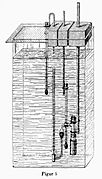Wilhelm Pfeffer facts for kids
Wilhelm Friedrich Philipp Pfeffer (born March 9, 1845 – died January 31, 1920) was a German botanist and plant physiologist. He was born in a town called Grebenstein. He became famous for his important discoveries about how plants live and grow.
Contents
Wilhelm Pfeffer's Education
Wilhelm Pfeffer started his studies at the University of Göttingen. There, he learned about chemistry and pharmacy. Some of his teachers were famous scientists like Friedrich Wöhler and William Eduard Weber.
After Göttingen, he continued his education at other universities. He studied at the Marburg and the Berlin universities. In Berlin, he worked with Alexander Braun and was an assistant to Nathanael Pringsheim. Later, he also worked as an assistant to Julius von Sachs at the Würzburg.
Becoming a Professor
In 1873, Wilhelm Pfeffer became a professor at the University of Bonn. He taught about pharmacology and botany. He then moved to other universities. He became a professor at the Basel in 1877. A year later, in 1878, he moved to the University of Tübingen. There, he was also the director of the botanical garden.
In 1887, he became a professor at the University of Leipzig. He also directed the botanical garden there. In 1897, he was chosen to be a member of the Royal Swedish Academy of Sciences. This was a great honor for his scientific work.
Wilhelm Pfeffer's Discoveries
Pfeffer was a pioneer in modern plant physiology. This means he was one of the first to study how plants function. He was very interested in how plants move.
How Plants Move
He studied how flowers open and close. Some flowers move based on temperature (this is called thermonastic movement). Others move based on light (this is called photonastic movement). He also looked at how leaves move at night, which is called nyctinastic movement.
He also studied the physics of protoplasts. A protoplast is the living part of a plant cell. He also researched photosynthesis, which is how plants make their own food using sunlight.
The Pfeffer Cell and Osmosis
In 1877, Pfeffer was studying how plants use and change energy, a process called plant metabolism. During this time, he created a special membrane. This membrane had tiny holes, allowing some things to pass through but not others. He used it to study something called osmosis.
Osmosis is a process where water moves across a special membrane. It moves from an area with a lot of water to an area with less water. This happens to balance the amount of water on both sides.
Pfeffer built a device called an osmometer. This device helped him measure the pressure created by osmosis. This device is now called the "Pfeffer cell" after him. It was a very important tool for understanding how water moves in plants.
- Pfeffer cell
-
The Pfeffer cell determines the osmotic pressure of a solution.
-
The Pfeffer cell was composed of a porous earthenware container, with a copper ferrocyanide precipitate, connected to a manometer.
Plants and Photography
While working in Leipzig, Pfeffer wrote about using photography to study how plants grow. He wanted to make a "movie" of plant growth. He planned to take pictures frame by frame over several weeks. These pictures would be taken at regular times. When played together, they would show the plant growing. This method later became known as time-lapse photography. Today, time-lapse is a common way to show slow changes quickly.
Wilhelm Pfeffer's Books
Wilhelm Pfeffer wrote many important books and papers about his research. Here are a few of his well-known works:
- Physiologische Untersuchungen (Physiological Studies) - 1873
- Lehrbuch der Pflanzenphysiologie (Textbook of Plant Physiology)
- Osmotische Untersuchungen – Studien zur Zellmechanik (Osmotic Studies – Studies on Cell Mechanics) - 1877
- Beiträge zur Kenntniss der Oxydationsvorgänge in lebenden Zellen (Contributions to the Knowledge of Oxidation Processes in Living Cells) - 1889





